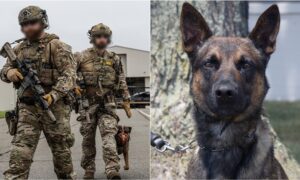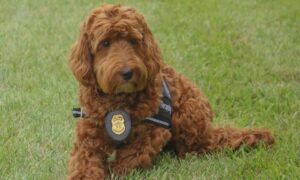“This post contains affiliate links, and I will be compensated if you make a purchase after clicking on my links.”
A police dog, often referred to as a K9 Dog, is trained specifically to assist police and other law-enforcement personnel in their work. Today, police forces in use k9 dogs to track criminals, sniff out drugs and bombs, search buildings, and do other jobs human police officers can’t do as well as they can. There thousands of police dogs on the job on any given day, and there are hundreds of police dogs who have given their lives to protect and serve. Andrea L. Chaffin of the Wilmington News Journal reports about the training these dogs go through and what is involved in handling a K9 Dog.
Paw Enforcement: Handling a K9 Dog
Dan Funk, a deputy with the Greene County Sheriff’s Office, has one suggestion for anyone considering smuggling drugs in his county: Don’t.
That is, unless you would like to meet Roy, his highly trained German Shepherd, and Roy’s titanium coated teeth.
Funk is one of three K9 law enforcement officers who have been training with their furry counterparts in Sabina at the cattle distribution center owned by John Surber.
Richard Coy, a sergeant with the Wright State University Police Department, trains with Funk and said that the dogs still haven’t even touched one quarter of the monstrous building.
“I’m always trying to find areas to train because we don’t want the same environment – we want different environments,” he said. “I used to work in Port William as a cop and turned around and made contact. The owner of building is allowing us to come over and train. It helps build our relationship with the community and we can use our dogs in this area, also.”
The dogs train once a week to keep them “up on their feet,” Coy said.
“We’re always on call at all times. “We do narcotic searches, explosives searches, article searches and building searches.”
Coy and Funk also train with Greene County Sheriff’s Deputy Dennis Nipper, who has the “old man” of the group — Rex.
Rex and Roy are multi-purpose K9s, meaning they can conduct various duties including attacking a suspect upon command, searching for narcotics, articles, and even people themselves inside a building.
“They lay down when they find an odor,” Coy explained, as Rex circled a grassy lot outside the distribution center.
“We put out human scent odors,” Funk continued. “Say, if somebody robs a bank and throws a gun on their way out, we’ll send em’ out and they‘ll find an article – anything anyone has touched.”
That includes keys.
Their dogs are different from bloodhounds, where they are given a scent and they go out and find it, Funk said. “We give our dogs a fresh scent and they start tracking.”
Coy has been a K9 handler for three-and-a-half years, and was the first at Wright State’s department.
His dog, a yellow lab named Tito, is a single-purpose dog. Tito searches for narcotics.
All three dogs scratch at the spot where the narcotic is hidden. For training purposes, the officers brought heroin, marijuana, ecstasy and cocaine. When each dog discovers the drug, a toy is thrown at the object, making it seem like the toy comes from the odor.
But Rex, the old man, is a cheater. He looks from behind his shoulder and waits for the toy, which will soon be annihilated anyway, to be thrown his way.
“We go to work for a pay check, but this is all a big game for them,” Coy said. “They go to work for a toy. It took me forever to find out what his favorite toy was – a tennis ball. He’s pretty cheap to work with.”
Dogs can normally serve on a force for eight to 10 years, depending on health, and are an important component of every force.
For example, if an officer stops a vehicle and suspects narcotics, they can go ahead and bring in the K9.
“It’s an extra tool for us” Coy said. ” Like our mace or gun or taser, it’s another tool to help our law enforcement agencies combat drugs.”
But being a K9 handler isn’t everything one may assume. It means long hours and strenuous work, mostly because only a few are authorized for the position. Therefore, those few are in constant demand.
Oh, and you live with your dog full-time. Sometimes, Tito gets mad when Coy leaves in the cruiser without him and throws a fit “just like a child.”
“It’s a full-time relationship,” Coy said, after taking off “the bite suit” for a pursuant exercise. “It’s almost like another kid in your family. You spend a lot of time with them with training and pet care time — free time. When they’re at home, they’re just a dog. They can play and have fun.
“But, when they’re at work, it’s just like we are — everyone has a job to do and they know what their job is.”
Dogs and people have been working side by side for many years, but few dogs are asked to give as much of themselves as police dogs. You can read the rest of the article about handling a k9 dog here. What’s your opinion of dogs in law enforcement? Let us know in the comment box below.






















It applies that top quality professionals which may have in-depth information about market and industrial
trends frame the curriculum. Some technical recruiters are paid a
particular per cent of the hired employee’s salary while many get paid the hourly rate with the successful
applicant. Distance learning coursesare also offered under programs
of MBA in Canada.